2016 MXA RACE TEST: EVERYTHING YOU NEED TO KNOW ABOUT THE KTM 150SX
Q: FIRST AND FOREMOST, IS THE 2016 KTM 150SX BETTER THAN THE 2015 KTM 150SX?
A: The 2016 KTM 150SX is all new from the ground up and shares very few parts with last year’s 150SX. The 2016 KTM 150SX’s handling, suspension and engine characteristics are a night-and-day difference from the 2015 models.
Q: WHAT CHANGES DID KTM MAKE TO THE 2016 150SX CHASSIS?
A: When KTM developed its 2016 motocross line, it made the decision to update every SX and SXF model (save for the KTM 250SX). Thus, every transferable modification that the KTM engineers made to the 450SXF they made to the 150SX. But, because of the unique nature of a two-stroke versus a four-stroke, there were updates to the KTM 150SX that were quite a bit different from the ones made to their bigger brothers. Here is a list of chassis updates.
(1) Frame. The chromoly steel frame has been lightened and provides 20 percent more torsional rigidity and 30 percent less longitudinal stiffness.
(2) Geometry. The head angle has been steepened by 0.4mm and the wheelbase shortened by 10mm.
(3) Paint. Back in 2015 KTM granted our wish, and the wish of the vast majority of KTM owners, by painting the frame orange. For some Scrooge-like reason they dropped the orange in 2106.
(4) Subframe. The aluminum subframe is smaller and 20 percent lighter.
(5) Swingarm. To the naked eye the 2016 swingarm looks the same as the 2015 model, but the internal structure has been revised to match the flex characteristics, and it is lighter.
(6) Footpegs. The all-new footpegs are a work of art. They are self-cleaning to reduce dirt build-up in the hinge for optimum function in the worst conditions.
(7) Triple clamps. The offset remains the same (22mm), but the handlebars are now rubber-mounted to reduce vibration at the handlebars.
(8) Airbox. The no-tools airbox has been updated to be even simpler, and the filter is the first-ever plug-and-play design. It’s impressive.
(9) Fork settings. The quick-adjust WP 4CS fork settings have been updated and use softer springs (from 4.4 N/m to 4.2 N/m).
(10) Shock. The 150SX gets the latest-generation WP shock. It features a revised reservoir, new piston, new shock shaft and new clevis design that shortens the shock length by 12mm. The linkage is also an all-new design to fit the architecture of the new frame.
Q: WHAT CHANGES DID KTM MAKE TO THEIR 2016 150SX ENGINE?
A: The goals for the 2016 150SX engine were to reduce weight, centralize mass and improve performance. Every part of the 2016 engine has been re-engineered since 2015. KTM even left a hint that the 150SX could possibly be fitted with electric start in the future. The major changes are as follows:
(1) Both the clutch shaft and crankshaft have been raised for a more compact package that increases centralized mass.
(2) The engine is 4 pounds lighter overall.
(3) An electric starter could be in the 150’s near future, as the cases have been designed for the possibility. But most likely on the offroad XC version.
(4) The laundry list of other changes includes a new cylinder, piston, head, crankshaft, six-speed transmission and shared 125SX/150SX exhaust pipe.
Q: WHAT ELSE IS NEW ON THE 2016 KTM 150SX TWO-STROKE?
A: The following upgrades weren’t model-specific but rather brand-specific updates. Model-specific changes are ones that are introduced only on one model, like the KTM 150SX’s top-end parts, while brand-specific modifications are done to every bike in the company lineup.
(1) Bodywork. All the bodywork, from nose to tail, is totally reworked. The front number plate incorporates the front brake-hose guide. The embossed sag line on the rear fender is a cool detail that helps with accurate sag measurements.
(2) Radiators. The WP-built radiators are redesigned to improve engine cooling, and the new radiator guards improve flow. Also, there is no more need for aftermarket radiator braces.
(3) Brakes. The Galfer Wave rotors have a different design to their vents and are lighter than before. Call us crazy, but we think the pucker power of the brakes is down a smidgen from last year.
(4) Tires. Although the previous 2015 KTM model line was outfitted with Dunlop MX52 tires, KTM felt that its bikes deserved a more dirt-specific racing tire. So, for 2016, all the KTM motocross bikes come with Dunlop MX32 tires.
Q: WHAT ARE THE DIFFERENCES BETWEEN A 125SX AND A 150SX?
A: Both the KTM 125SX and 150SX share the same basic suspension, frame geometry, shock linkages, brakes, wheels and overall design, but they aren’t identical.
(1) Displacement. The 150SX is really a 143.99cc. The 125SX is 124.8cc.
(2) Bore and stroke. The 150SX’s bore and stroke is 58mm by 54.5mm, while the 125SX’s is 54mm by 54.5mm. Sharing the same stroke means the cylinders are interchangeable. The 125SX can be made into a 150SX and vice versa.
(3) Gearing. More power can pull taller gearing, thus the 150SX comes with 13/48 gearing while the 125SX gets 13/50.
(4) Parts. The cylinder, piston, power valve, head stays, power valve governor spring and rings are different on the 125SX and 150SX.
(5) Pipe. We originally thought that KTM had built a special pipe for the 150SX because KTM’s website photos showed two different pipes. This was wrong.
(6) ECU. The ECU is the standard KTM unit, but the 150SX has different mapping.
(7) Jetting. The 150SX has a bigger main and pilot jet, as well as a different needle.
Q: HOW FAST IS THE 2016 KTM 150SX?
A: When it comes to power to the ground, the KTM 150SX can run with any 250F powerplant. The issue isn’t how much power the 150SX has, but the nature of its high-rpm powerband. Compared to a four-stroke powerband, the 150SX’s feels peaky and narrow. When the dirt offers decent traction, the 150SX can run with 250 four-strokes, but it takes a talented rider to stay on the 11,500 rpm peak. Helping it stay competitive is its 198-pound dry weight (without fuel in the tank). That is over 20 pounds lighter than any 250cc four-stroke, even the ultra-light KTM 250SXF and YZ250F.
To successfully use the 150SX as a race bike, you have to take the temperament of the engine into consideration. The engine revs quickly, makes its best power in the top end and signs off fast (it makes its max power at 11,500, and 500 rpm later it’s a weak sister). Selecting the proper shift points is key to keeping this smoker in the meat of the power. In some ways the potent power curve makes the KTM 150SX harder to ride than a 125SX. In the past most MXA test riders choose to race the KTM 125SX over the 150SX because it had a more organic powerband, cleaner shift points and better transitions through the midrange. Now, for 2016, with a few extra ponies added to the 150SX’s power profile and a gearing change, our testers are starting to soften towards the extra ponies of the 150SX—but only a little.
Q: HOW DOES THE 2016 KTM 150SX RUN ON THE DYNO?
A: Hold on to your hats! The 2016 KTM 150SX makes a whopping 40.60 horsepower and 18.63 foot-pounds of torque on the dyno. That is a hair more horsepower that the 2016 Yamaha YZ250F makes. Plus, the 2016 KTM 150SX makes almost 2 horsepower more than the 2015 KTM 150SX. If you compare the 2015 KTM 150SX to the 2016 KTM 150SX on the dyno, they are a fair match from 6000 rpm all the way to 11,000 rpm. Then—whammo!—the 2016 model takes off like a scalded cat, while the 2015 model begins to fade. The 2015 KTM 150SX peaks at 38.81 horsepower at 11,000 rpm, while the 2016 model peaks at 40.60 at 11,500 rpm. Even more telling, at 12,000 rpm the 2015 bike is making 32.90 horsepower, while the new model is still pumping out 38.00 horsepower. Horsepower is up, peak is moved up 500 rpm, and sign-off, albeit drastic after 12,000 rpm, is later. No matter how you slice it, this is one powerful two-stroke.
Q: IS THE 2016 KTM 150SX SUSPENSION BETTER THAN THE 2015 SUSPENSION.
A: Yes, but not just due to the updated WP suspension. Last year’s chassis was old technology, albeit only a couple years old, but it made the previous WP suspension feel worse than it actually was. The all-new chassis and suspension components allow the 2016 KTM 150SX to handle leaps and bounds better than in previous years. Given the light weight of the 150SX, the WP 4CS forks don’t have to work as hard as with a heavier or more powerful bike. That is why they feel so much more usable. Both the front and rear suspension are plush from the top of the stroke to the bottom. Our biggest bugaboo was that with an aggressive rider on a track with big jumps, the forks could and would bottom out. For the light, small and entry-level riders that the 125 and 150 market aims for, however, this is an okay setup.
Is it as good as the YZ125’s Kayaba SSS suspension? We applaud KTM for closing the huge gap that Yamaha has on them, but we still give SSS a standing ovation and WP 4CS a golf clap.
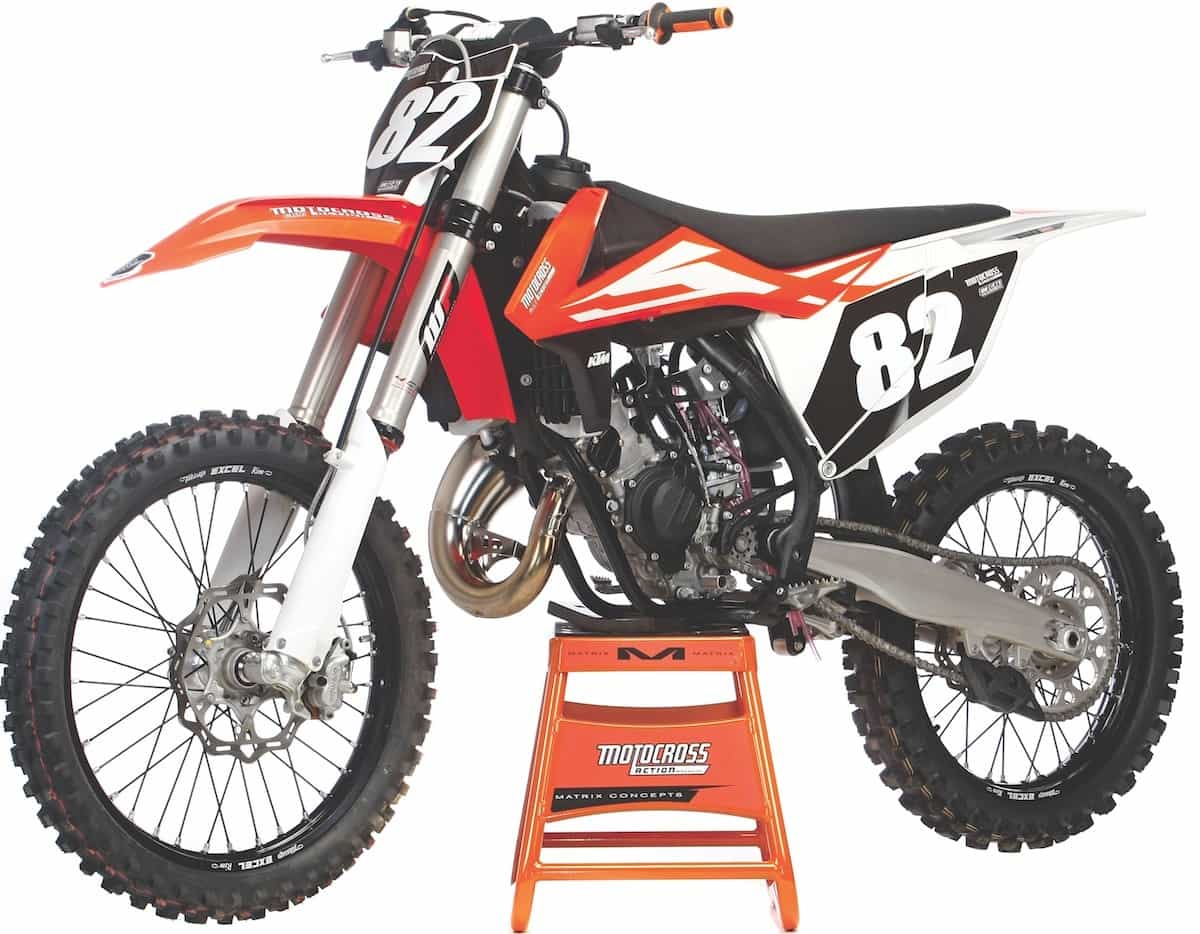 Feather: Two-strokes are light. That means you can get them up on a stand easier and whip them around in the air. The 150SX weighs 23 pounds less than the lightest 250 four-stroke.
Feather: Two-strokes are light. That means you can get them up on a stand easier and whip them around in the air. The 150SX weighs 23 pounds less than the lightest 250 four-stroke.
Q: WHAT IS THE ONE CHANGE EVERY 150SX OWNER SHOULD MAKE?
A: Gearing. Stock gearing on the 150SX is 13/48. Forgive us, but this is one part of the bike that has remained the same. The 13/48 combo has been on the MXA hate list each and every time it has appeared. We understand KTM has to find a happy medium for those who will purchase this bike, and we understand that the majority will be Vets, play riders and kids (in transition from the minis), but the stock gearing is an unhappy compromise that never sits right with the MXA wrecking crew. Over the last two years we have begun to develop distinctly different gearing solutions to our issues. Riders who are less talented, older or just looking for the thrill of the punch should gear it down by adding one tooth to the rear sprocket (turning the stock 3.692 gear ratio into lower 3.769 ratio). The second strategy is for more talented riders who can carry speed through the corners and keep the throttle pegged. For these riders, we went to a larger countershaft sprocket (14 instead of 13) and added one tooth to the rear. Compared to 13/48, this gearing is taller (3.500 to the stock 3.692), which lengthens the shift points, allowing for smooth transitions between gears. This helps with shifting under a load and produces a more fluid style of power. Yes, it requires more talent to use, but it has its rewards.
 What don’t we like about this brake pedal spring. The tang sticks out of the pedal and can be hit by the rider’s boot—which will knock the brake pedal spring off. We turn the spring around so that the bottom tang faces inward.
What don’t we like about this brake pedal spring. The tang sticks out of the pedal and can be hit by the rider’s boot—which will knock the brake pedal spring off. We turn the spring around so that the bottom tang faces inward.
Q: WHAT DID WE HATE?
A: The hate list:
(1) Gas cap vent hose. KTM’s vent hose gets twisted in a knot when you take it on and off to fill the tank. Plus, the gas cap tends to stick.
(2) Sprocket bolts. Watch them like a hawk, as they come loose quickly.
(3) Gearing. We found a more linear, easier-to-ride powerband by going up on the gearing, but it only works for fast riders.
(4) Grips. All the 2016 four-stroke KTM SXF models got upgraded to ODI lock-on grips. And guess what? We love them. The KTM 150SX has last year’s orange and black grips. We don’t love them.
(5) Black frame. We don’t hate the black frame color; we just hate that they changed it from orange to black.
(6) Fork clickers. Although you love the ability to change the compression rebound stetting on the WP forks without having to dig in the toolbox for a screwdriver, the cog-shaped clicker needs to have longer cogs so that the clicks can be made much quicker and easier.
 Cones: The KTM 150SX and 125SX share the exact same exhaust pipe—which makes switching cylinders cheaper.
Cones: The KTM 150SX and 125SX share the exact same exhaust pipe—which makes switching cylinders cheaper.
Q: WHAT DID WE LIKE?
A: The like list:
(1) Price. Two-stroke pricing will rise as the smokers get more popular, but right now they are much cheaper than anything with a camshaft. The 125SX costs $6799; the 150SX is $6899; the 250SX is $7399; the 250SXF is $8399; the 350SXF is $9099; and the 450SXF is $9299. That makes the KTM 150SX $2400 cheaper than a 450SXF, $2200 cheaper than a 350SXF and $1500 cheaper than a 250SXF. You could fund a lot of racing fun with that dough.
(2) Weight. At 198 pounds the 2016 KTM 150SX is 8-1/2 pounds lighter than the 2015 model and 23 pounds lighter than the typical 250 four-stroke.
(3) Brakes. They are not as strong as last year’s, but they are better modulated.
(4) Hydraulic clutch. Hydraulics must be new technology, because Honda, Yamaha, Suzuki and Kawasaki haven’t heard of it.
(5) Airbox. We don’t think changing an air filter could get any simpler. The air filter actually plugs into the airbox. Very trick.
(6) Sag line. This small detail on the rear fender makes life a lot easier.
(7) Easy-adjust forks. We love that you can pull off the side of the track and adjust the forks without tools, but see #6 above.
(8) Suspension. The WP suspension components, along with the new chassis, are much better than before.
(9) Fuel. Our 2016 KTM 150SX ran well on 91-octane pump gas, but we always added a dash of C12 as a precaution.
(10) Tires. We vastly prefer this year’s MX32 tires over last year’s MX52, especially in the front.
(11) Silencer. Although most riders will switch to an aftermarkert exhaust and silencer the stocker’s mounting system is very well thought out.
(12) Play bike. Although designed as a race bike and built on the exact chassi as the 125SX, the 150Sx is really the go-to choice of professional practice riders. It’s a great play bike—and better for that task han the 125SX because its extra oomph makes it more cpapabale of getting over big kickers.
Q: WHAT DO WE REALLY THINK?
A: Let’s be serious! This is a 40-horsepower, under-200-pound machine that sells for thousands of dollars less than the typical four-stroke. The 150SX is an extremely fun bike to ride. The light weight, agile feel; plush suspension; and 40-plus horsepower will allow you to out-ride the majority of 250Fs on the track (whether your talented enough to do that is up to you). And, believe us, they don’t like getting passed by a 100cc smaller smoker.
MXA’S KTM 150SX SETUP SPECS
This is how we set up our 2016 KTM 150SX for racing. We offer it as a guide to help you find your own sweet spot.
WP FORK SETTINGS
It was easy to find a happy medium for just about any size rider with the updated WP 4CS forks. We had riders from 135 pounds to over 200 pounds who found a setting that worked for them. Raising the forks into the clamps 1mm above the second line improved cornering and provided a more balanced feel. The spring rate is softer than last year’s, going from a 4.4 N/m to 4.2 N/m. The following settings are what worked best for a 170-pound Vet or Novice. For heavier or lighter riders, we just adjusted the compression accordingly and left the rebound alone. Here is what we ran (stock settings in parentheses):
Spring rate: 4.2 N/m
Compression: 5 clicks out (15 clicks out)
Rebound: 16 clicks out (15 clicks out)
Fork-leg height: 6mm up (5mm)
Notes: The fork spring rate is light because of the target weight of the typical 125/150 rider. The KTM 250SXF has 4.6 N/m springs and the 350/450SXF has 4.8 N/m springs. Lighter riders can turn the compression clicker out to get the feel they want.
WP SHOCK SETTINGS
KTM’s overall plan with the chassis, along with the updated WP shock and rising-rate linkage, was to soften the shock spring rates considerably (going from 48 N/m to 42 N/m). For hard-core racing we recommend this shock setup for the 2016 KTM 150SXF (stock specs are in parentheses):
Spring rate: 42 N/mm
Race sag: 102mm
Hi-compression: 2 turns out
Lo-compression: 6 out (15 out)
Rebound: 9 out (15 out)
Notes: We use the high-speed compression damping to lessen G-outs in conjunction with more rebound than the recommended setting. Additionally, we set the sag at 102mm instead of the more traditional 100mm or KTM-recommended 110mm.
KEIHIN PWK 38S JETTING SPEC
Here’s what we ran in our 38mm PWK (stock settings in parentheses):
Main jet: 190
Pilot: 52
Needle: NOZE needle
Clip: 4th clip from top
Air screw: 3 turns out (1 turn)
Notes: Listen for pinging, as the KTM 150SX has historically pinged on low-grade fuel and in cold weather or deep sand.



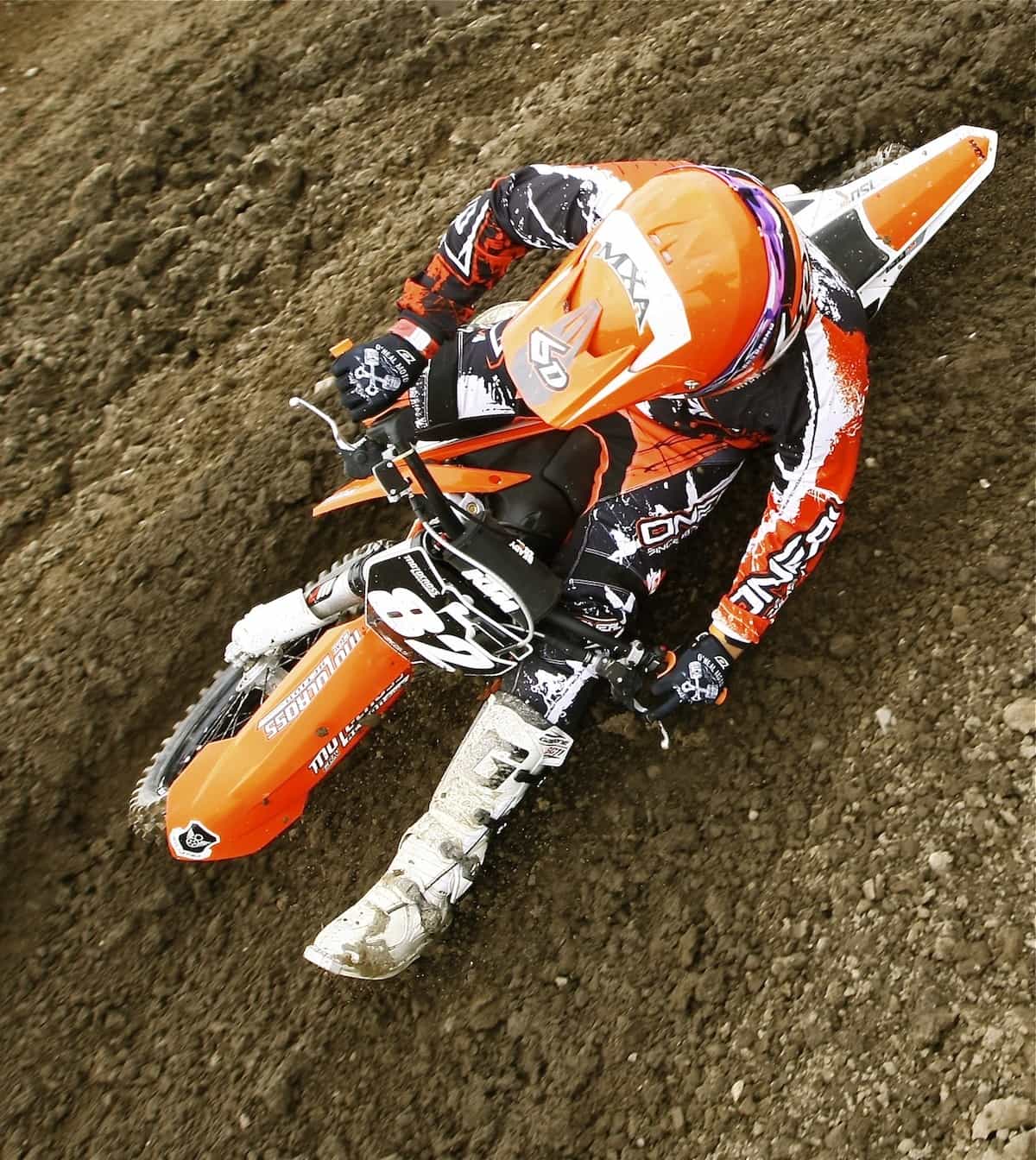
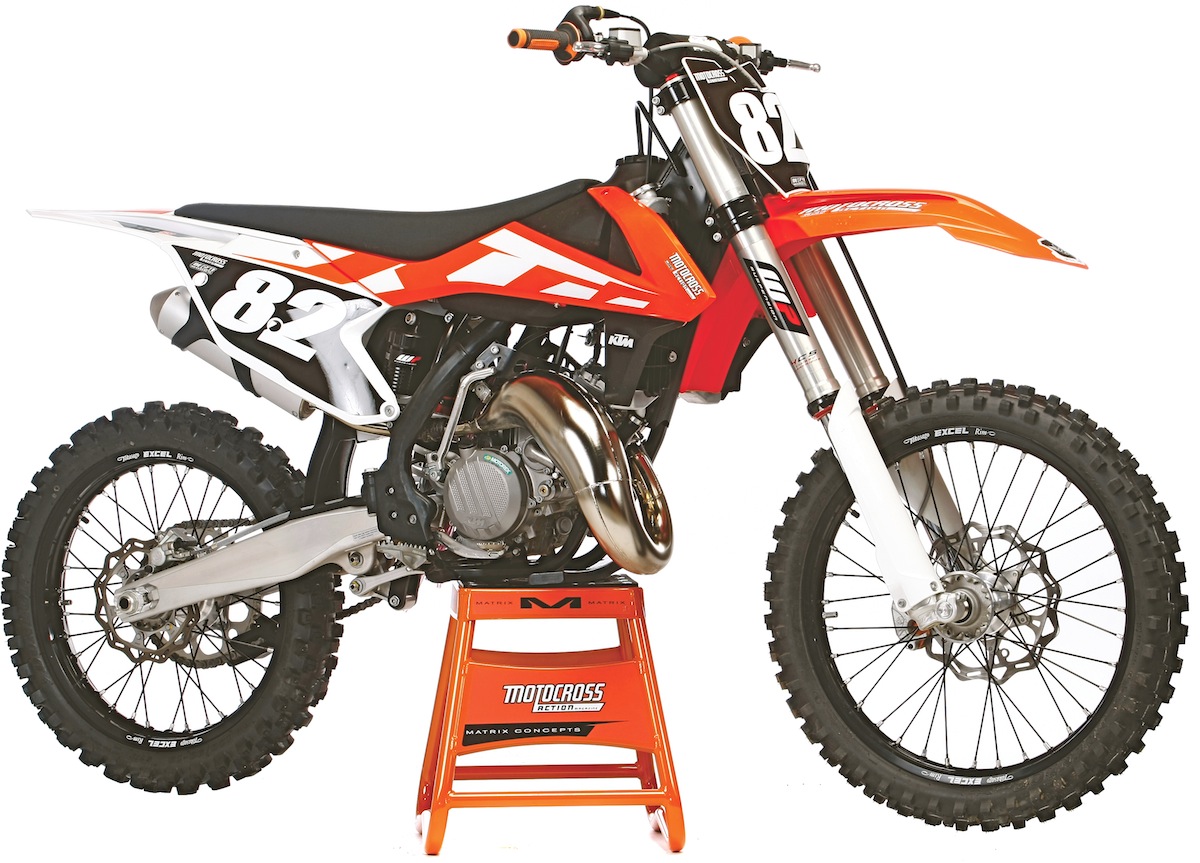
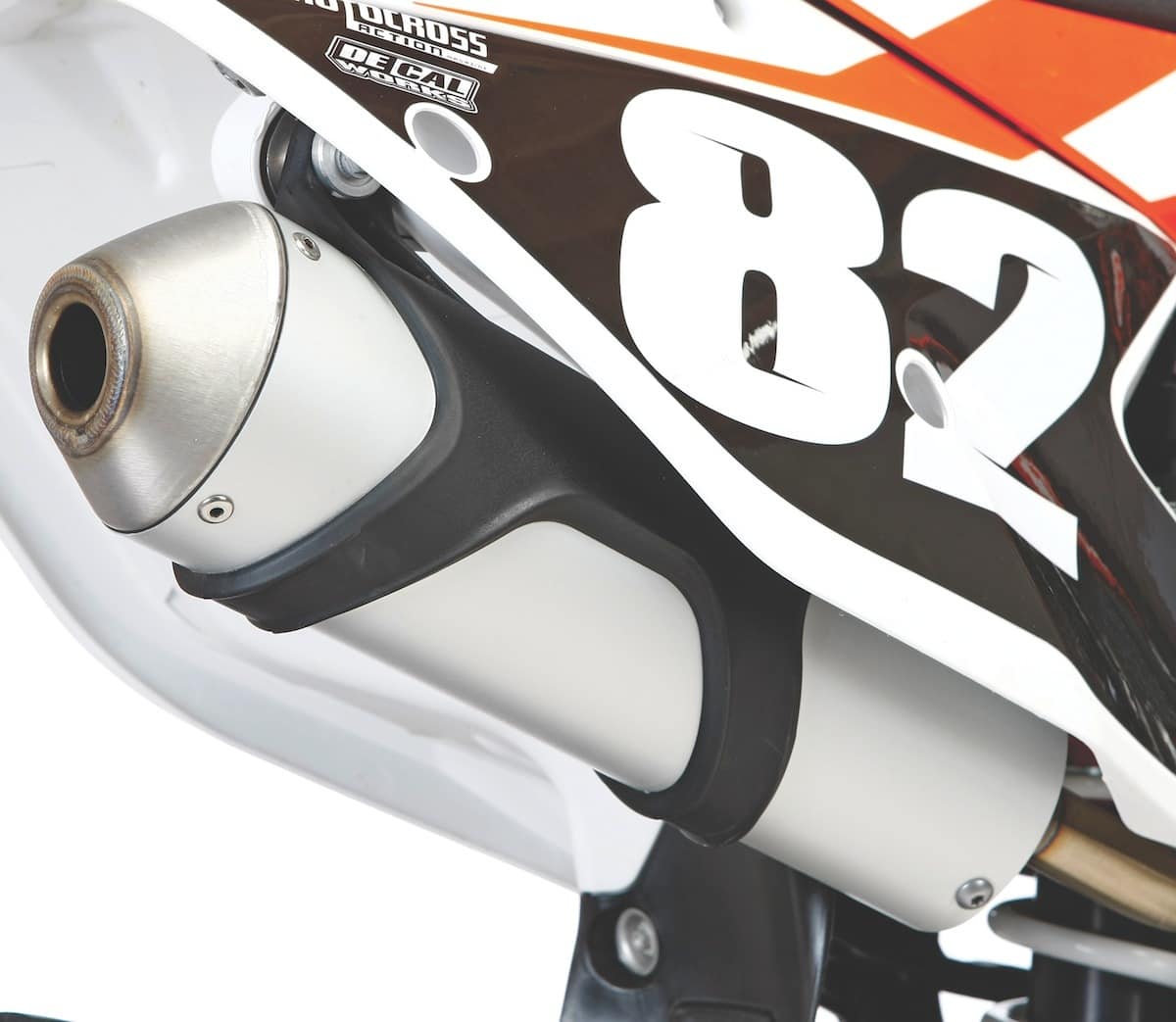

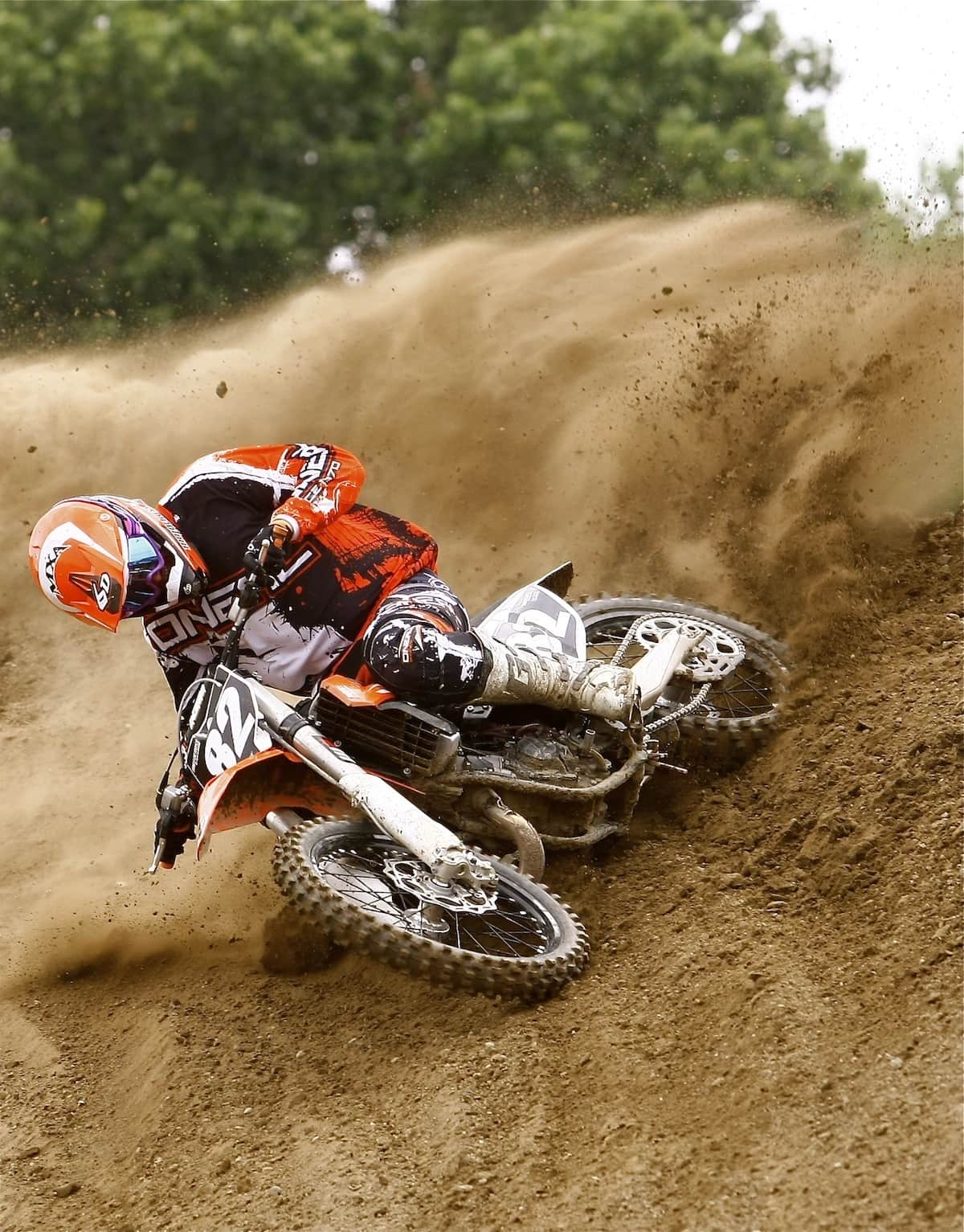

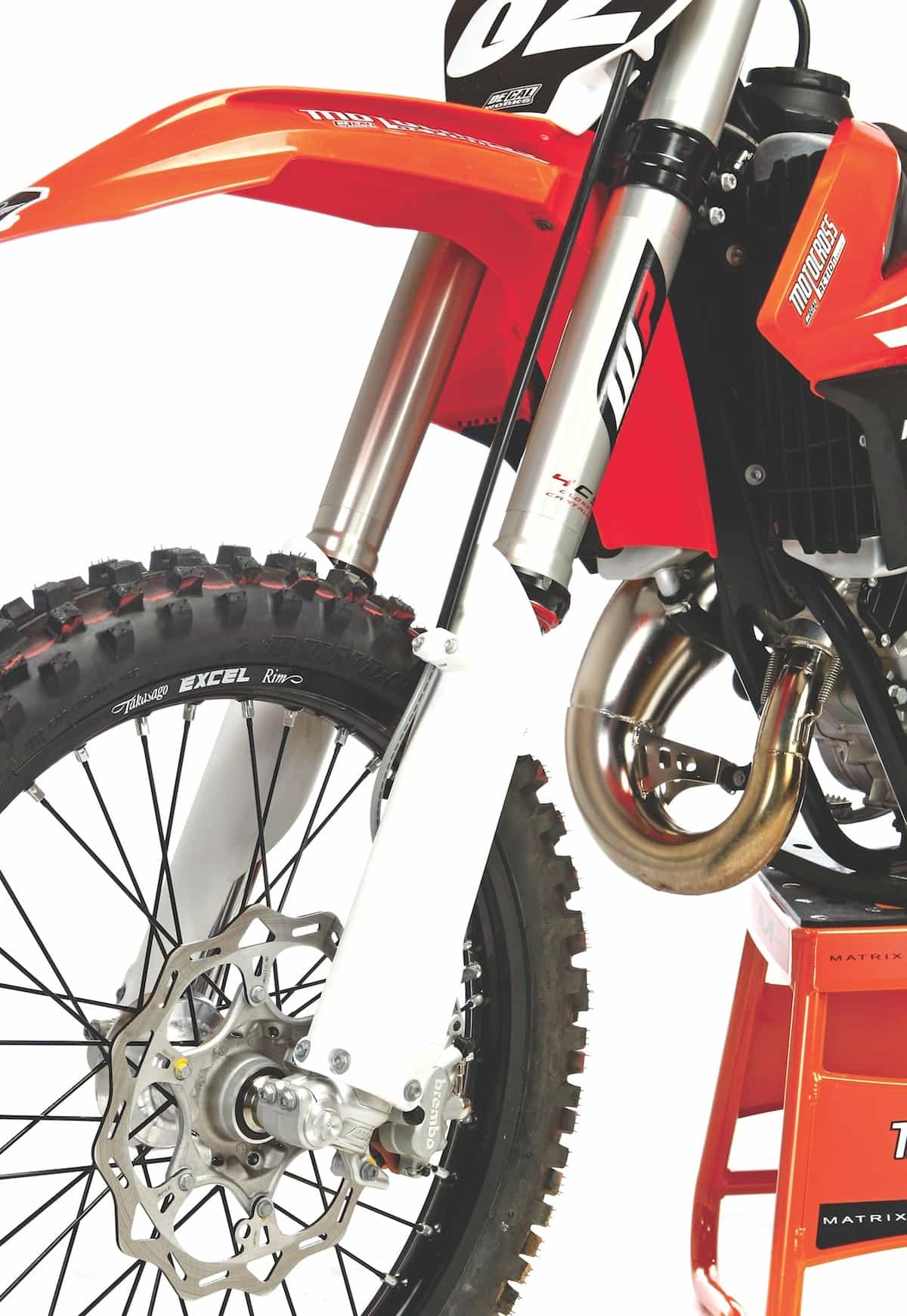


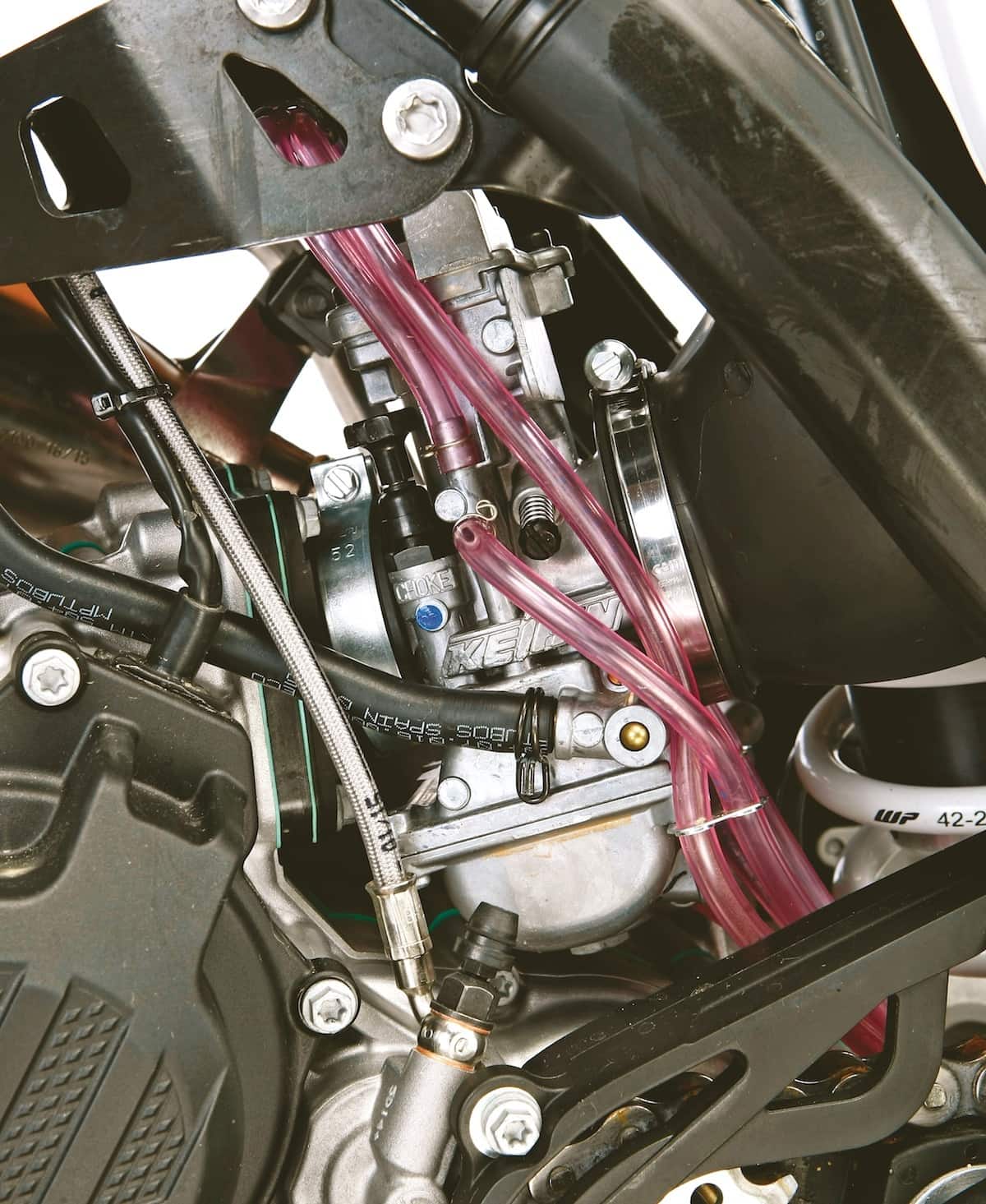


Comments are closed.